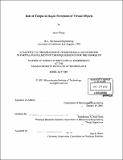Role of torque in haptic perception of virtual objects
Author(s)
Wang, Steve, 1977-
DownloadFull printable version (5.730Mb)
Other Contributors
Massachusetts Institute of Technology. Dept. of Mechanical Engineering.
Advisor
Mandayam A. Srinivasan.
Terms of use
Metadata
Show full item recordAbstract
An experimental study was performed to determine the role of torque feedback in haptic perception of object location within virtual environments. The experimental setup consisted of two Phantom haptic interfaces connected by a common stylus and a raybased rendering technique for modeling the interactions between the user-controlled stylus and the virtual environment. Subjects were asked to identify 7 locations of a virtual object under various force display conditions, which ranged from force feedback only at the stylus tip to accurate force and torque feedback. Subjects' ability to determine the location of a real object was also examined in order to establish the effectiveness of the hardware and software utilized in the study. In order to obtain their best performance, subjects were trained in each case with correct-answer feedback. Results indicate that the most significant improvement in perception occurred during the first training session. The accuracy of subjects' haptic perception of virtual object location was the same as the perception of real object position when full force and torque feedback were provided, thus validating the realism of the simulated haptic environment. Estimated percentage JND for these conditions, ranged from approximately 20% for the nearest objects to 12% for the farthest objects. The information transmitted (IT) for these conditions were also the same, at approximately 1 bit (out of a maximum of 2.81 bits). When subjects probed the virtual object by rocking against it, thus freely changing the orientation of the rod, even with forces reflected only at the front tip of the stylus, performance was the same as when true force and torque feedback were provided. However, when subjects were permitted only to tap the probe against the object, thereby limiting the motions and orientations of the rod, providing force feedback only at the tip of the stylus resulted in poor identification of object location. In this case, percentage JND ranged from 37% to 27%, while IT was .17 bits. Torque feedback and object contact with multiple probe orientations, then, provide equivalent haptic information in terms of determining object position. Denying both results in inaccurate haptic perception of object distance.
Description
Thesis (S.M.)--Massachusetts Institute of Technology, Dept. of Mechanical Engineering, 2001. Includes bibliographical references (p. 87-88).
Date issued
2001Department
Massachusetts Institute of Technology. Department of Mechanical EngineeringPublisher
Massachusetts Institute of Technology
Keywords
Mechanical Engineering.
